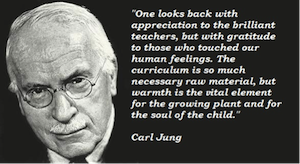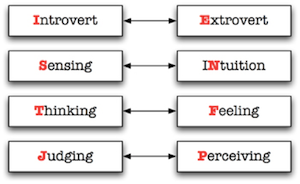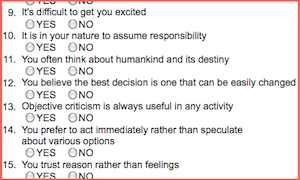Giving Students All We’ve Got
A MiddleWeb Blog

I’ve just turned my whole co-teaching perspective inside out and upside down.
My focus has always been on what I — and we — can do for the students (with my attention zoomed in on our students with disabilities). My new perspective places the needs of my co-teacher at the top of the agenda.
Wow, what a mind opener! It makes crystal clear sense to me. Let me explain for those skeptics out there. You see, before we can successfully put our students first, we have to make sure that we have three perspectives in place:
- a strong sense of self
- a strong sense of our partner’s self
- a strong sense of how the two come together to give the students all we’ve got!
My belief that students come first is still my main focus. But I realize that to truly make students the center of all we do, I must view the needs of my co-teachers as an urgent priority. Does this make sense to anyone else?
Let’s think some about the need for teachers to be more aware of their own personality and teaching preferences—as well as the preferences of their co-teachers. The trick is how do we gain this sense of understanding of ourselves and our co-teachers? I think I may have found the path to a solution.
Personal understandings

The Myers-Briggs personality preferences were based on their extensive study of the work of Swiss psychologist Carl Jung. Jung believed that people perceive the world through four main psychological functions: sensation, intuition, feeling, and thinking. Additionally, Jung believed that these four mental functions characterized a person’s overall general attitude as primarily introverted or extroverted.
Myers and Briggs took Jung’s theory and put it into language that could be useful in everyday life to guide people to understand themselves and others. I believe that this four-minute test can work to strengthen the language of co-teaching. Before we go on, let’s take a four minute break to take the test: just click here.
Know yourself
OK. So I’m an INFJ — specifically introvert, intuitive, feeling, and judging. What a relief! This explains so much! My results do not surprise me. I’ve always known that I prefer tranquil and quiet settings vs. crowded social scenes. I am not one of those who speak loudly and draw attention to myself. In fact, my most effective way to get the attention of a crowd or classroom filled with students is by speaking softly. And truth be told, I would rather sit peacefully reading a book than going to a crowded party.
Also, I know I drive some of my co-teachers crazy as I strive to find time to plan with them. I am that squeaky wheel that just doesn’t stop until the right amount of oil is added — hence, my result of “judging.” INFJs are known to be organized planners and proactive solution seekers. That explains why I twitch when I am put in a classroom situation where I am expected to just “jump in” without a co-planned lesson. Although I am able to go with the flow, I am always thinking that my students deserve more than that.
I know I will continue to strive to co-plan and be proactive for my students, but my new inside-out perspective is reminding me to take the knowledge of my own preferences and then ask myself, what can I do for my co-teacher—first and foremost? Why? Because I believe that my focus on my co-teachers’ needs will allow me to reach my ultimate goal of giving my students all I’ve got!
I am using this Myers-Briggs test as a tool for understanding how my personality can work side by side with my co-teacher’s personality. I think it will be a natural process. At least I hope so, because I work with three different co-teachers—three different personality types—and there’s only one of me.
Know Your co-teacher

Even if a co-teacher does not take the test, you can use the language to help you to understand your partner’s preferences.
For example, another one of my co-teachers is clearly an extrovert who also must have a preference for perceiving rather than judging. Not only is co-planning an issue, but he is extremely social with students and colleagues. In addition, he yearns for the limelight when in the classroom, which can be definitely overpowering to my more reserved self.
He seems to view co-teaching as a threat to his desire to have the students’ attention on him. Rather than see this as a problem, my knowledge of this just makes me more aware of my need to consider the reality of the situation. I understand this co-teacher’s needs and respond to them, so in turn he is more welcoming of my contributions. And this connection goes a long way toward building that mutual respect that co-teachers need.
Rather than getting frustrated that a co-teacher is not interested in co-planning, I know I will have to kick it up a bit. My old approach was all about trying to find the time to plan and then to use that time effectively. But some people are just not cut out for that, so I will problem solve by planning on my own and then going to him and say, “How about we try this…”
I think it will work. He’ll be happy because he won’t be forced to sit and plan ahead. I’ll be happy because I will sit and plan ahead. And we’ll both be happy because the needs of the students will be met. So it will be a good compromise — it will be a balance of thought out plans and going with the flow on the spot teaching. Life is good.
My hope is that the emphasis on my planning and then sharing with him will turn into a natural connection between us — leading to a stronger co-teaching experience during the actual moments of teaching. And who knows, maybe it will even evolve into a shared desire to co-plan. I’ll let you know how it all unfolds. I’m really psyched about this! (Definite pun intended!)
A tool for co-teachers
This Myers-Briggs approach has really helped me to relax and find that balance that Laurie spoke about in her last post. For me, it is helping solve that all-too-familiar problem of building positive co-teaching relationships. It’s a solution because it confirms the value of my own preferences and teaching style, as well as helps me to understand the preferences and styles of others. I can move forward in constructive ways and communicate effectively.

So, what do you think? Could this be a solution for you or anyone you know?
And for all of you who read this post but didn’t actually take the Myers-Briggs test — go on and do it. It’s really kind of fun. And the four minutes required to take the test could possibly transform endless hours of co-teaching time. So, just click here…and let us know what you think about questions like:
- How does the knowledge of your attitude and preferences help you to get along with your co-teacher?
- How can the knowledge of yourself help you to keep your focus even if your co-teaching experience is fraught with challenges?
- How can this help you to understand your co-teacher’s needs and ultimately meet the needs of your students?
Let’s chat!


































Although I am a skeptic about learning style tools (given the reserachj), I agree that teachers need to understand each others’ approaches, values, goals and views of students’ potential–in the best interests of their students. Each brings a different knowledge base and skill set; both are essential to student success.
Elizabeth,
Thank-you so much for teaching us about ourselves. I knew I was an extravert, at least in the classroom, but it’s so helpful to learn about the sensing, feeling and judging that also make up my personality. I know I must drive my colleagues crazy with my random thoughts that often feel like a middle schooler on overdrive (I tend to be the one who jumps up in the middle of a science lesson on phases of the moon when kids are confused, leave the room to grab a yellow Nerf ball out of the closet to show the sun, or put marker on it to show that there’s really not a “half moon.”)
I think we do need a sense of who we are in relation to our teaching partners’ personalities (thankfully my partners aren’t hyper like me or we’d be constantly have trouble staying on task!) I think it helps me appreciate that just like our students are all very different, so too, are our co-teaching partners. I jokingly once said to a dear friend when we were chatting about our spouses, “Would you really want to be married to you or do you like that your spouse is different than you?” we agreed that our differences compliment one another; so too can our different personalities in the classroom.
Fran, I know what you mean about being a learning style skeptic! I, too, continue to fine tune my perspective on that subject. Here’s a great read on the subject: http://www.middleweb.com/3674/how-might-students-like-school/ . I think Daniel Willngham offers teachers much to think about, and I enjoyed Bill Ivey’s book review.
On another note, thanks for sharing your view about the importance for teachers to place understanding one another as a top priority. I have become so much more balanced in my approach now that I remain aware of my personal personality preferences along with my co-teachers’ preferences. We all know that poster that hangs in so many classrooms: “Attitude is a little thing that makes a big difference.”
Oh, Laurie, you make me laugh! Just think of the fun we would have if we shared a classroom! Our ESFJ and INFJ preferences would definitely complement one another….
The key here is how do co-teachers build this rapport of acceptance? I am excited to hear what are folks out there are doing to ensure a strong sense of self and a strong sense of one another? Or not. Is there anyone out there who is struggling in this area?
Do share–we can learn so much from one another…
Often, what is good practice with kids is also good practice for adults. So this year, we decided to spend the first few weeks of middle school team meetings building community. We went back to the mission statement of our school as well as “This We Believe” from AMLE (c.f. http://www.amle.org/aboutamle/thiswebelieve/the16characteristics/tabid/1274/default.aspx ) to talk about the foundational values and principles of our school. And we all took Myers-Briggs, and our Head of School facilitated a discussion around that. I think it was valuable not just for learning about our own individual styles as well as those of our colleagues, but also for helping us appreciate the need for a range of styles to help the team be successful.
P.S. I, too, am INFJ as is my Head of School. And my wife. :-)
P.P.S. Thanks for the kind words about my book review! Dan Willingham has a great way of making me think and re-evaluate what I do.
Bill, What a great way to get the year off to a strong start! Thanks for sharing your story about this practice in action. It is also great to hear from other INFJs as well as Dan Willingham enthusiasts!